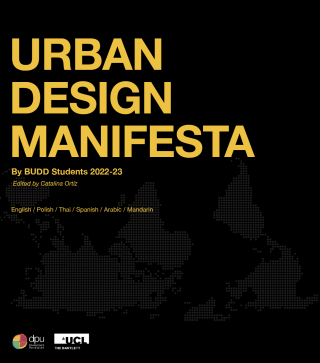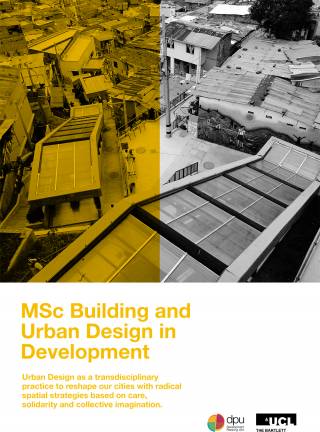As part of our module 'Critical Urban Theory and Design', our Building and Urban Design in Development MSc students engage in an urban design exercise with a local stakeholder.
About our UK practice engagements
As part of our core module 'Critical Urban Theory and Design', and within the framework of an urban design exercise, we encourage our Building and Urban Design in Development MSc students to critically reinvent the development brief as a tool for urban-design-driven transformation. In response, our students undertake fieldwork and propose a critical alternative for transformation in a series of urban environments in partnership with a local stakeholder.
Therefore, urban analysis moves beyond an enquiry over the socio-spatial dimensions of an urban area, to incorporate local narratives, stakeholders’ imaginations, human and non-human mobilities, investigations over conditions of alterity, dynamics of seclusion and dispossession or displacement, mechanisms of care. Vision statements are equally re-thought, attempting to move away from the production of empty mottos and slogans that inevitably perpetuates profit- and growth-driven understandings of urban transformation.
How can we devise a loose-though-inclusive framework of principles and guidelines that could steer transformation effectively, while at the same time embracing the complexity and multi-vocality of the urban realm, and the call for just and sustainable development?
Since 2012, the main focus of our investigations across our UK practice engagements in the module has been on East London and its post-Olympics Transformation. We have partnered with local institutions and organisations operating in Silvertown, North Woolwich, Albert Island, and Custom House , in London's Royal Docks area, at the South-Eastern end of Newham’s so-called ‘arc of opportunity’. We have dug deeply into a contested regeneration process driven by Newham Council’s (and the Mayor of London’s) vision of a hub for international investment driven by sustainable technology, business parks, and housing.
During the period of COVID-19 related lockdowns, we also took advantage of the remote nature of our investigations to understand the area within the wider regeneration of the Lea Valley and three urban transformation projects related to such process: St Andrew’s in Bromley-by-Bow, Chobham Farm in Stratford, Hale Village in Tottenham Hale. At the Royal Docks, we focused on the redevelopment of Royal Wharf and Silvertown Quays. The exercise was fundamental for our students in grasping how regeneration discourses and imaginations, but also the dynamics of seclusion and dispossession, replicate across scales and places, though with apparently different connotations.
We look forward to continuing our focus on the contested transformation of East London, and to supporting the agency of community-based initiatives.
Our previous UK practice engagements
Discover where we've worked and the organisations we've partnered with in previous years:
2020 to 2021: Silvertown Quays and Royal Wharf, St Andrews, Chobham Farm, and Hale Village
2019 to 2020: Custom House
In 2019 to 2020, we partnered with Newham Council who contacted us on the Building and Urban Design in Development MSc to reason on opportunities for a people-centred transformation of Custom House, against the background of a regeneration process sustained by a participatory agenda.
We had started co-producing knowledge on the area back in 2012-13, partnering precisely with Newham Council. We focused firstly on the area of North Woolwich, with a specific concern for the supposed isolation of the area and the potential transformation of Pier Parade — which was identified as a catalyst for community-driven activities. We then moved to Albert Island shifting the focus to an apparently leftover and empty piece of urban land, read through its connections towards Beckton and North Woolwich. We speculated on the possible transformation of the island while keeping in mind the development restrictions imposed by the proximity of the London City Airport. We then embarked into a critical appraisal of Silvertown Quays regeneration project, sitting at the heart of the Royal Docks basins and leveraging upon its built heritage. Against the fascinating background of the Millennium Mills and other elements of industrial archaeology, we argued for (and attempted to portray) a critical alternative for the future of the area, mindful of its relationship with the socio-spatial fabric of the surroundings and of the potential civic vocation of the new public spaces to be created.
2018 to 2019: Royal Docks / Croydon
After a hiatus of two years in Lewisham, working first with Deptford Neighbourhood Action (on the regeneration of Convoys Wharf and its impact on Deptford), and Lee Neighbourhood Forum (on the contested regeneration of Leegate), we moved back to the Royal Docks in 2018-19, partnering with our alumni from the Royal Docks Community Voice (RDCV) and running the exercise in parallel with Croydon Council, fostering a cross-local dialogue over spaces artificially constructed as derelict, their profit-driven regeneration, and spaces of opportunity for bottom-up resignification.
2017 to 2018: Lee
- Read the student reports from our 2017-18 practice engagement on Lee
- Cultivating Connections: Establishing Networks and Encouraging Centrality (PDF)
- Lee-vability (PDF)
- Leegate - A People Friendly Place. Urban Development Report (PDF)
- Reviving Lee Through Socio-economic and Spatial Transformations (PDF)
- The Anchor and the Stitch (PDF)
- Transgressing Thresholds: Dialogues of Difference (PDF)
2016 to 2017: Convoys Wharf
- Read the student reports from our 2016-17 practice engagement on Convoys Wharf
- Activating Agency in Deptford (PDF)
- Connecting the Dots: Past, Present and Future (PDF)
- Crea(c)tive Deptford (PDF)
- Healthy Deptford (PDF)
- Interweaving Deptford (PDF)
- Knitting Deptford (PDF)
- Deptford: Managing the Change (PDF)
- Deptford: Navigating Change Together (PDF)
- Deptford: Respecting the past, embracing the present, moving forward together to create a Deptford for all (PDF)
- Reviving Connections: Realizing the social potential of Deptford’s public realm (PDF)
- Smart + Connected Neighborhood (PDF)
2015 to 2016: Silvertown and the proposal for the expansion of the London City Airport
- Read the student reports from our 2015-16 practice engagement on Silvertown
- Capturing Potentials: Development Brief for Silvertown, Royal Docks & North Woolwich (PDF)
- Design for the Forgotten (PDF)
- Revitalising Silvertown: Small Action, Big Change. Urban Design Principles for Placemaking (PDF)
- Space to Grow: A development brief for North Woolwich/Silvertown (PDF)
- More Than Liveable: Development Brief of the Royal Docks 2016 (PDF)
- Creating New Urban Reality: Re-Envision, Reconnect, Revitalization (PDF)
2014 to 2015: Silvertown Quays
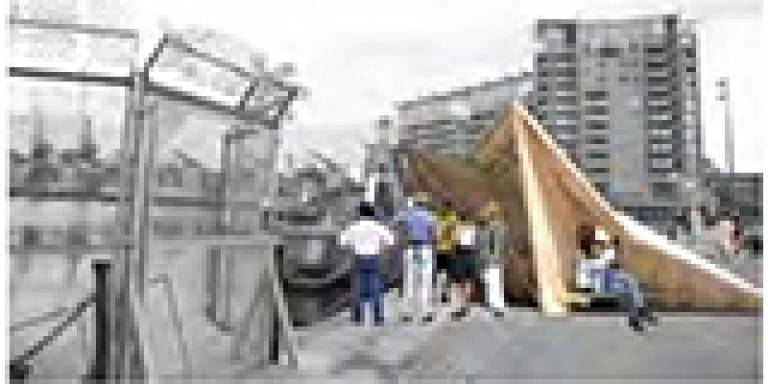
In Silvertown Quays, we revisited our public engagement strategy and started liaising more closely with community-based organisations, initially with The Momentum Project, and then with ASTA Community Hub. ASTA, part of the wider network of spaces and activities of Community-Links, proposed to us to work on the proposal of expansion for the London City Airport, which would have threatened the Silvertown neighbourhood, where the Hub is. From this experience, importantly, a group of students moved to constitute Royal Docks Community Voice (RDCV), which has since then operated in the area supporting a wider neighbourhood planning momentum.
2013 to 2014: Albert Island

2012 to 2013: North Woolwich
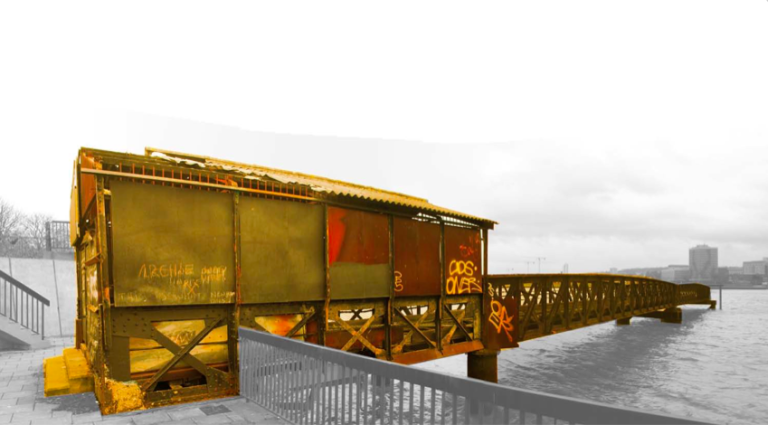
2012: Elephant & Castle

2011: London Borough of Enfield
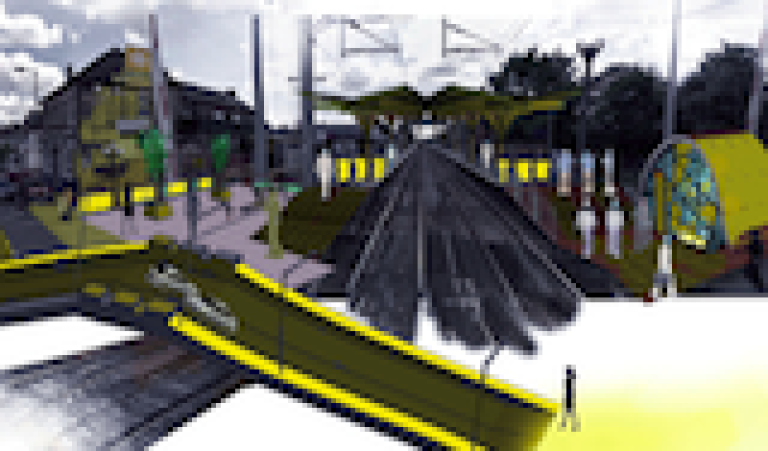
2010: Bishopsgate Goods Yard

2009: Shoreditch
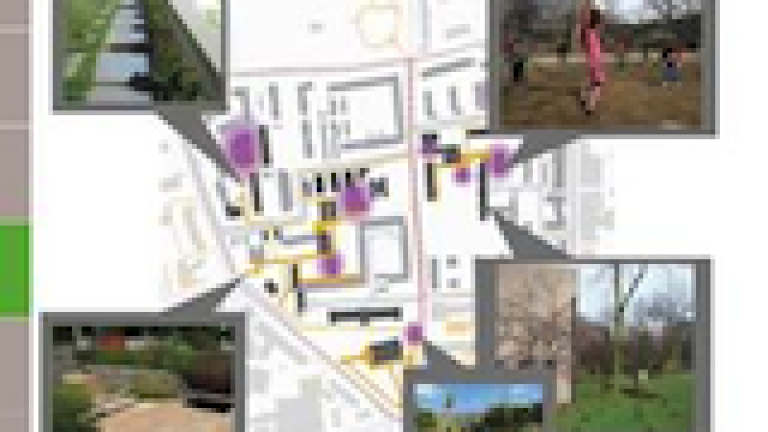
 Close
Close


